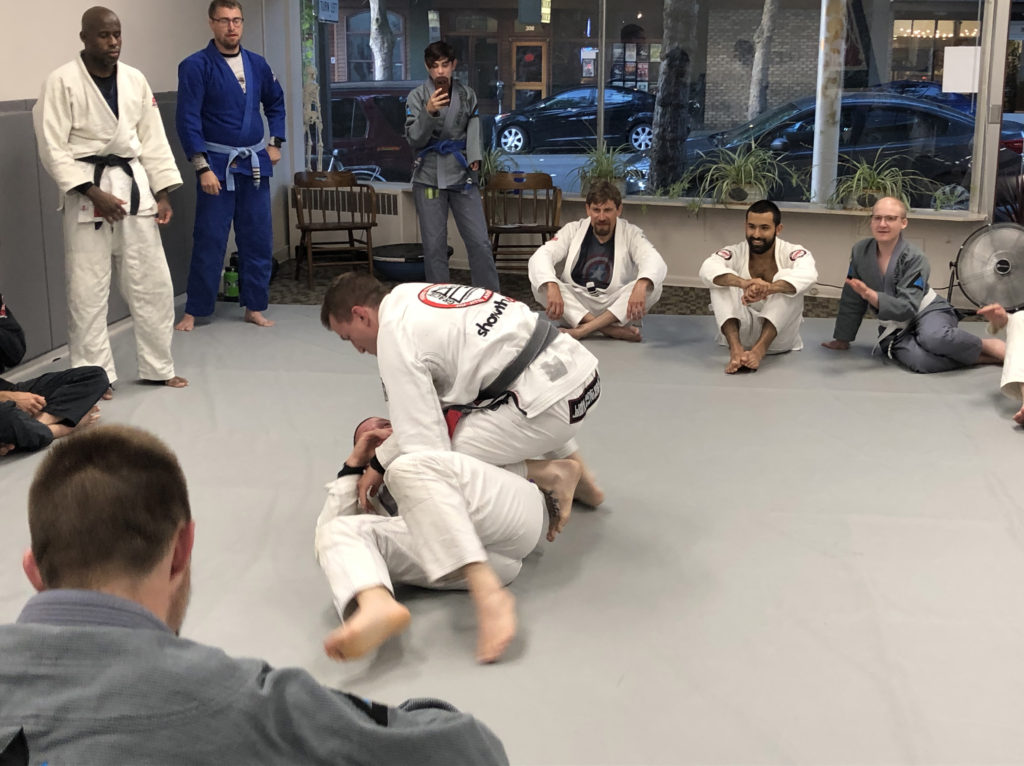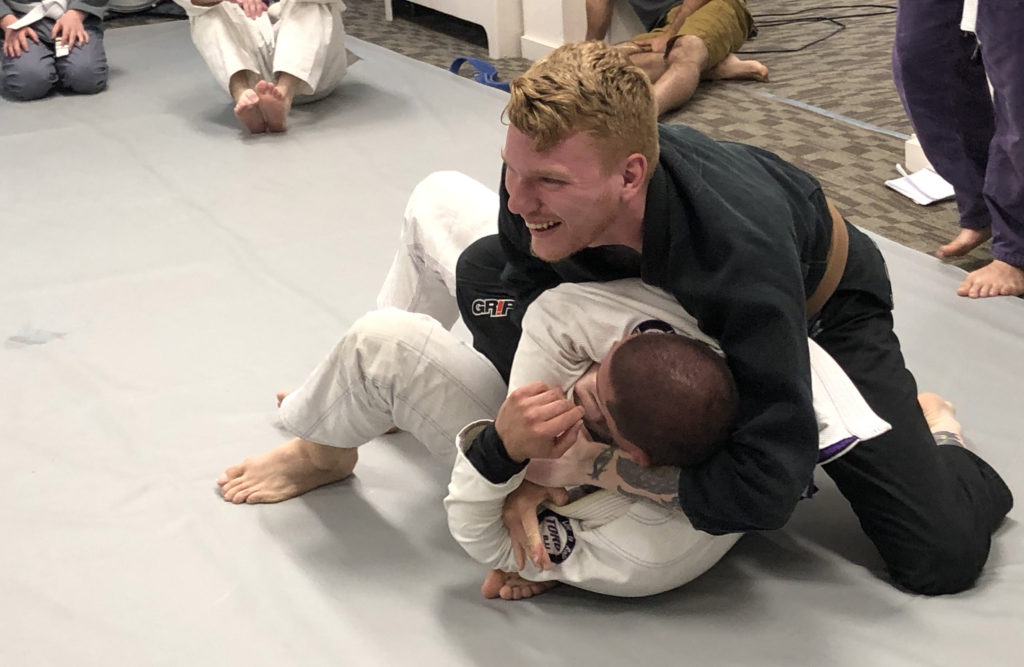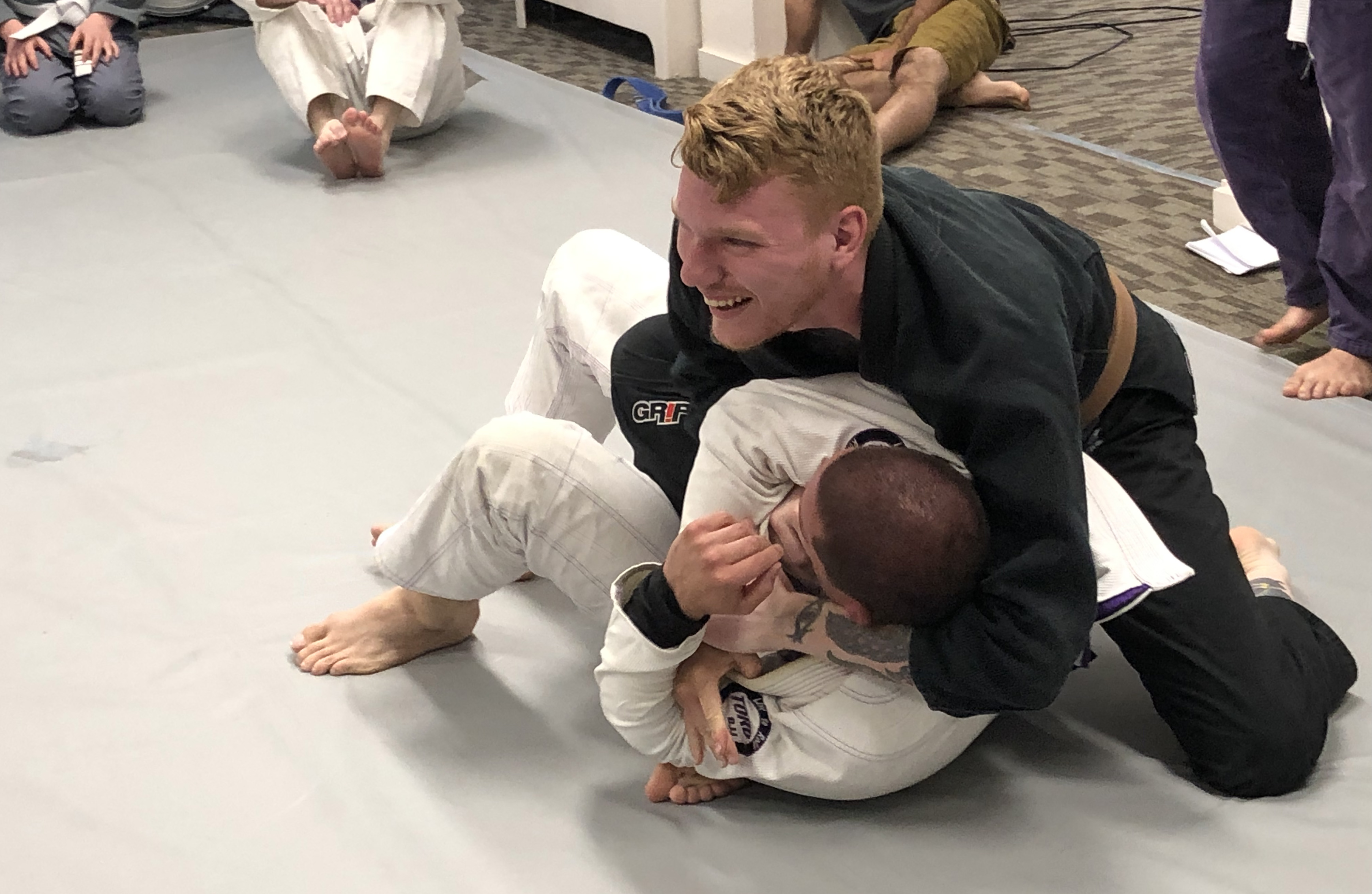Rituals are important.
When I got my blue belt, the promotion itself meant a lot to me — but what meant just as much was going through the Triangle Jiu-Jitsu “belt train,” which was our ritual for newly-promoted students.
I’ll tell you about the TJJ train in a moment, but the point of this post is to explain what our Bellingham BJJ belt promotion ritual is — and what happened when we did it for the first time ever tonight.
The TJJ train is tough. I’ve been through one at each belt level, and so have all of my teammates. Here’s how it goes: Every student in the class lines up from lowest rank to highest. The instructor sets the clock for one minute intervals. Every minute, a new, fresh person jumps on you and tries to destroy you.
Usually, when their minute is up — signified by a train whistle — the person who is leaving holds you in position for the next person to jump into a dominant spot on you, like a tag team wrestling match. For blue belts, this lasts at least 15 minutes (mine was 18). Purple is at least 30, brown at least 45 and black belt an hour or more.
If this sounds long and hard, it is. That was the point, and we all did it. Because the new folks start and you build up to the top folks, by the time you’re really tired … the line is getting to the place with the folks who beat you up even when you’re fresh. This leads to encounters such as this one:
So, I love our belt train tradition from Triangle Jiu-Jitsu. I had friends take photos and videos of all my trains, and at least two images from my trains have become a popular meme that surfaces twice a year or so.
It might sounds strange to some, but I treasure these memories and experiences. I’m grateful to have gone through it. It makes way more sense to me than other rituals, such as the gauntlet (where people whip you with their belts) that don’t seem related to the skillset you’ve developed in jiu-jitsu.
I firmly believe that jiu-jitsu is for everyone, though — and the train is definitely not for everyone.
It’s not even the physical challenges and risks of injury, although those are real. Some folks (guilty!) actually enjoy videos and photos of them getting smashed. Others, not so much, and if not, you might not see the good in the train.
The good in it is that it’s difficult, and challenges you, and forces you to use your jiu-jitsu in a high-stress situation where you’re focused on survival. And when you’re done, you really feel like you’ve done something.

The bad in it is that — even if you make it optional — some people shouldn’t do it. It’s risky: Injuries happen; claustrophobia spikes sometimes, and people have a bad experience. Plus, there’s always the one person (or more people) that takes advantage of the rare chance to crush someone they couldn’t ordinarily do anything to. There’s social pressure to do it even if you make optional (as TJJ did in later years).
This raises the question: How do we preserve the good of the train — it’s strenuous, and it is about skill — while minimizing the bad?
That’s what we asked ourselves when deciding what the Bellingham BJJ promotional tradition was going to be. We put a lot of thought into this … and put that thought into practice for the first time tonight.
We start off with a one-minute grappling round between one of the instructors and the student. Everyone in class is in a circle around this grapple as it happens.
When that round ends, instead of another grappler jumping in, I call out a technique from either the blue belt requirements or the purple belt requirements … and have someone from the circle jump in for the student to demonstrate on. For that minute, the student will drill the move (or moves) and demonstrate knowledge. The student must crisply demonstrate those moves.
Now we’re in the 3rd minute. For the third minute, the student rolls with another instructor, or one of the black or brown belts. At the end of that minute, we’ll call out more moves in order.
It continues like that, with one round of rolling and one round of demonstration drilling, until time is up.

The idea is that this captures the technical benefits and the toughness benefits of the train (I guarantee that the student will be tired at the end of this). Eventually, we will let other students in on the rolling portions, but I want to set the expectations of what is OK to do to people and what isn’t during the course of the train — so that’s why it’s instructors and black and brown belts only at first.
We surprised two students with their trains tonight. Two students that I knew were ready had told me they’d be there; we’d done a ton of planning for this, and we wanted to see what happened when the rubber met the road.
The results were strong. Both students performed well, the upper belts had fun participating, and the white belts got to participate by having moves demonstrated on them. It was fun to engage the whole group.
Arranging the train in this way, we found, also preserves spontaneity. After each rolling round, the student has to demonstrate several moves, often at random, on different body types. We have a lot of folks showing up for fundamentals these days — 35 tonight — so that provides a lot of different partners to demonstrate moves on. And you never know what move is coming next!

Getting everyone involved is also a terrific bonding experience. If you’re part of someone’s jiu-jitsu journey, then you’re invested in them and in their success. Being tasked with something during this ritual is another manifestation of that. Jiu-jitsu isn’t just a thing we do — it’s a thing we do together.
I was really proud of the two students, Eric and Jose, who did their trains tonight. They were technical, tough, poised and positive, and nailed all the moves we asked them to show.
If you didn’t make it out tonight, well … just think about how many other people have four stripes on their belts about now.
There will be lots more trains at Bellingham BJJ, but there will never be another first night of trains, so this was special. Thanks to everyone who played a part in this first night of a new tradition.




Awe!
I would’ve stayed had I known!!!